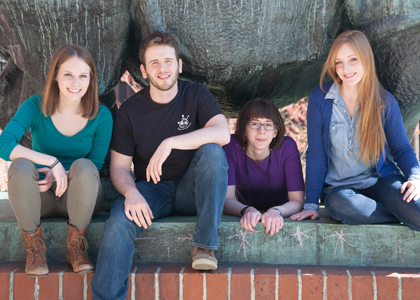(l to r) Alicia Darnell, Kyobi Skutt-Kakaria, Laura Bagamery, and Mackenzie Amoroso
Four first-year MCB graduate students have been awarded prestigious NSF Graduate Research Fellowships from the National Science Foundation. Mackenzie Amoroso, Laura Bagamery, Alicia Darnell, and Kyobi Skutt-Kakaria will each receive a three-year annual stipend of $30,000, along with a $10,500 cost of education allowance for tuition and fees, opportunities for international research and professional development, and the freedom to conduct their own research at any accredited U.S. institution of graduate education they choose.About the Research
Mackenzie Amoroso entitled her proposal to the NSF, “Breaking Boundaries: Lifting brakes on critical period plasticity in the auditory cortex.” She is interested in how circuits in the brain are shaped during periods of heightened plasticity, termed critical periods (CPs). Recent research identified molecular mechanisms that trigger the onset and control the closure of CPs, but questions remain about the endogenous circuit mechanisms that prevent premature plasticity or onset later in adulthood. Amoroso will study this regulation in the development of a critical period in the mus musculus auditory cortex. Specifically, Amoroso will examine the role of GAT-1, the primary GABA re-uptake transporter in the brain, as a pre-CP “brake” that controls the timing of CP onset.
Alicia Darnell wants to understand the range of molecular mechanisms through which non-coding RNAs can affect gene expression in cells. She proposed to study an unusual viral non-coding RNA called PAN (polyadenylated nuclear) RNA, which is encoded by the oncogenic virus Kaposi’s Sarcoma Associated Herpesvirus (KSHV). This RNA has a poly(A) tail and it accumulates to incredibly high levels in the nucleus during lytic stage infection. Some evidence suggests that PAN RNA’s role in normal viral gene expression depends on its primary sequence interactions with viral gene promoters and host chromatin modifying proteins. Other evidence suggests that an additional function may be independent of its primary sequence and involve interactions between its poly(A) tail and host polyA binding proteins. Darnell developed strategies to investigate both potential roles of PAN RNA in regulating gene expression. She hopes to discover novel, potentially conserved strategies for gene expression regulation by non-coding RNAs.
Laura Bagamery studies how bacteria display a range of morphological variation while sharing an enclosing cell wall composed of cross-linked peptidoglycan strands. For these continually growing and dividing cells to assume proper sizes and shapes, they must precisely and dynamically remodel the cell wall to preserve such targeted yet diverse morphologies. Understanding how they do so is potentially relevant for developing antibiotics. Bagamery proposed addressing this question in rod-shaped bacteria by investigating how polymers of the prokaryotic actin MreB regulate cell wall synthesis. She expects these studies to result in the first kinetic model of MreB polymerization and the first direct observation of MreB modulation in vivo. She hopes this work will help to explain how rod-shaped bacteria maintain cell wall integrity and proper shape during elongation, and that it may lead to new targets for antibiotics, a critical need in light of increasing antibiotic resistance.
Kyobi Skutt-Kakaria wants to know how a bacterial cell balances the need to identify and repel harmful viruses known as phages, while accepting beneficial foreign DNA that may aid in acquiring nutrients or evading antibiotics. He studies a newly appreciated adaptive immune system in bacteria that helps them resist viral infection. This proto-immune system is called CRISPR-Cas, for Clustered regularly interspersed short palindromic repeats (CRISPR) and their associated proteins (Cas). Cas proteins recognize a unique sequence in the phage DNA and insert that sequence into the CRISPR array. The bacterium recognizes this sequence in the viral DNA and cleaves it. Skutt-Kakaria proposes to determine the factors that assist Cas1 in vivo, and also the regulatory elements present in the leader sequence. He believes this work could help develop novel antibiotics that inhibit CRISPR-Cas in bacteria, making them more susceptible to phages. Also, the incorporation process of the CRISPR array could have applications in biotechnology.About the NSF Graduate Research Fellowship Program
The NSF Graduate Research Fellowship Program (GRFP) recognizes and supports outstanding graduate students in NSF-supported science, technology, engineering, and mathematics disciplines who are pursuing research-based Master’s and doctoral degrees at accredited United States institutions. As the oldest graduate fellowship of its kind, the GRFP has a long history of selecting recipients who achieve high levels of success in their future academic and professional careers.
For further information:National Science Foundation’s Graduate Research Fellowship Program


